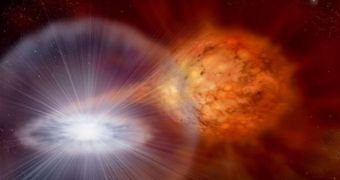Binary star systems are regular solar systems in all respects but one – they have two stars at their core, and not just one. The bodies revolve around each other, or around a common center of mass, depending on their configuration. One such system can be found in the Ophiuchus Constellation, where the pair is made up of a dying red giant, whose days are numbered, and an Earth-sized white dwarf. The gas exchange between the two goes wrong at times, and the entire setup blows up in very much the same way a hydrogen bomb does back here.
In their revolution around each other, the stars constantly interact. The red giant, which will soon completely die out, is currently shedding its atmosphere all around it, as this type of stars regularly does. The white dwarf, on the other hand, keeps sucking in all of the hydrogen-rich gas and accumulating it in its own atmosphere. Periodically, when the hydrogen concentrations reach a critical point, the white dwarf blows up and sends jets of gas hurtling all around, at speeds of up to a few hundred miles per second.
The binary system, known among astronomers as RS Oph, emits about 100,000 times more energy than our own Sun when the white dwarf goes crazy. Experts estimate that this happens about once in every 20 years, and that, when the explosion occurs, the amount of matter that is emitted by RS Oph is roughly equivalent to the mass of the Earth. That is, an Earth moving at hundreds of miles per second.
During the latest observations, astronomers have noticed that a space bubble of sorts has been created, following the explosion that was registered on February 12th, 2006, by a team of Japanese amateur astronomers. The peanut-shaped formation is moving outwards at speeds between 621 and 1,864 miles per second (1,000 and 3,000 kilometers per second), Space reports. “There are some astronomers who believe systems like this will ultimately explode as supernovae,” Liverpool John Moores University astrophysics researcher Valerio Ribeiro explained.

 14 DAY TRIAL //
14 DAY TRIAL //